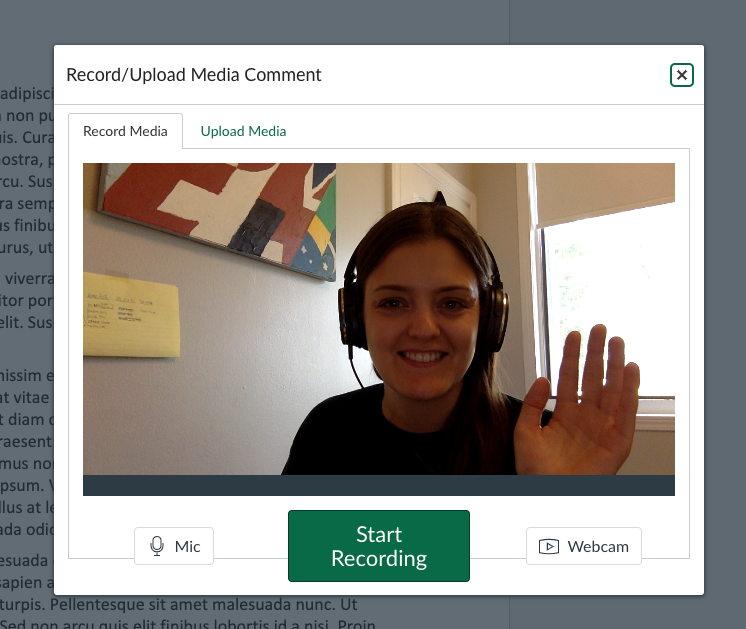Feedback is one of the most powerful ways in which instructors engage with their learners, and integral to the simple basis of formative assessment — i.e., provide opportunities for students to practice applying their skills and knowledge, give them feedback on how they’ve done, and then provide subsequent opportunities for them to show their enhanced performance and further their achievement. Because it can have such an impact on student learning, it’s valuable to consider how and where feedback is incorporated into your courses.
In this post, we’ll look at 3 broad approaches to providing feedback in an online course situation, and some tools that Canvas provides to enable effective feedback. I’ll also highlight some lesser-known Canvas tools, like leaving video comments on assignments or using the comment library to make giving feedback faster.
What Makes Effective Feedback?
There are many different frameworks and an entire world of research into what feedback is (or isn’t), and what makes for effective feedback that enhances student learning. According to Wiggins (2012), effective feedback is:
- Goal-referenced;
- Tangible and transparent;
- Actionable;
- User-friendly (specific and personalized);
- Timely;
- Ongoing; and
- Consistent.
With these keys in mind, consider how effective feedback might be delivered in your course via the following 3 broad online teaching strategies.
1) Individualized Feedback
There are many ways in an online course to provide individualized feedback — that is, feedback specific to one students’ performance on a particular task. A few ways in which to send individualized feedback in Canvas :
- Send a quick text comment via the Canvas Gradebook.
- Use Canvas SpeedGrader to send an assignment comment in the form of text, video, audio, or a file attachment.
- For text-based comments that you find yourself repeating to many students, you can use the Comment Library option to save and re-use snippets of text feedback.
- To communicate things that maybe just can’t be put into text, the audio or video comment option is very useful. This is also an excellent way to humanize your online course, and let your students connect with you, their instructor, as a “real” person who cares about their success! It can even potentially be faster than typing out text-based feedback.

-
- Media comments are also great for feedback that might benefit from more visual explanation; for example, you could screencast a quick walkthrough of an Excel spreadsheet to help a student better understand a certain process.
- The file attachment comment option can work really well for instructors who prefer a workflow in which you create more of your feedback outside of Canvas (e.g., in a Word document).
- Use the DocViewer in Canvas GradeBook to annotate student work, and tag specific parts of their submitted work that you wish to bring attention to in your feedback. You can draw on a document, place boxes around portions of it, or highlight passages of text.
Individualized feedback is still likely considered the ‘gold standard’ of feedback, because it is obviously the most specific and personalized way to give feedback. However, the realities of balancing planning, teaching, and grading time with the demands of crafting effective feedback means that, sometimes, it’s helpful to look for feedback strategies that cast a bit wider net. That is where generalized and automated feedback come into play.
2) Generalized Feedback
Generalized feedback refers to that which is directed at all of your students, or at a specific subsection of your class. Such feedback might be used to draw attention to a misconception that you saw repeatedly during a discussion, or a common error made on an assignment, of just a piece of advice that you think most (or all) of your class can benefit from. A few ways in which to send generalized feedback in Canvas are:
- Send an Inbox message or an Announcement for class-wide reminders or comments. If you know a course well or have taught it before, you might even be able to pre-plan and schedule your Announcements.
- Use the Inbox to selectively message students based on their progress on an Assignment (e.g., message only those students who have yet to submit).
3) Automated Feedback
Automated feedback refers to that which is built right into the content of the course. The instructor puts it into place ahead of time, and the feedback is available in a just-in-time fashion right when the student needs it the most. A few ways in which to build automated feedback into your Canvas course are:
- Use question-based feedback in Canvas Quizzes. This is especially useful for practice or ungraded quizzes, and you could even use the feedback to embed a Course Link to the specific part of the course that a student might need to review again, based on a quiz question that they answered incorrectly (e.g., “You got this question incorrect! Please spend some more time studying the material in Section 4.2 [add link here].“).
- Structure your content to physically separate exercises/questions from the feedback (i.e., answers/solutions) within your course. By doing this, students are encouraged to try an exercise/question before they proceed to look at your feedback or the “answer key”. This could also be considered a way to enable self-assessment in your course, where the students check their own work against a standard you have supplied. There are several ways to separate the exercises/questions from feedback in Canvas:
- Place the feedback on a separate Page within the Module. You could even keep the “feedback” page Unpublished (hidden) for a period of time before you allow students to see it.
- Place the feedback within an accordion that the student must click to open.
- Place the feedback into a Word document or PDF, and embed that document into the Page. If you allow “Preview inline” but not “Expand preview by Default”, the student needs to click to reveal the feedback.
And of course, a whole ‘nother world of automated feedback is possible if you build interactive learning activities with H5P, which can then be embedded right into your Canvas course. Imagine something like a branching scenario game where students get feedback tailored to the choices they make in the game.
For more info on anything feedback-related, contact gmctl@usask.ca.


